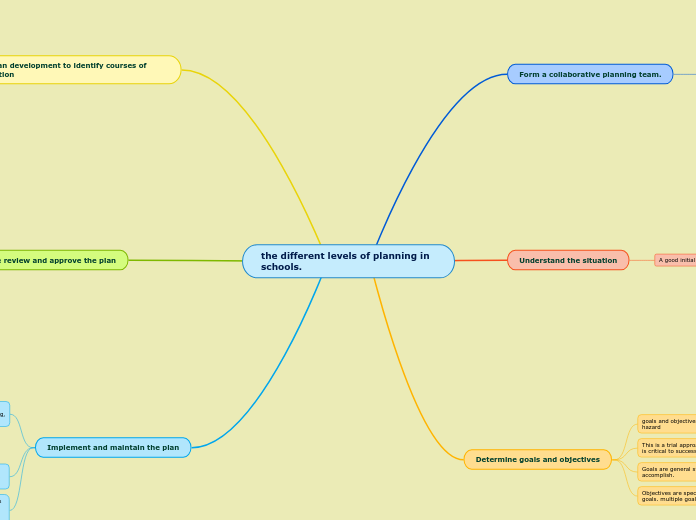the different levels of planning in schools.
Form a collaborative planning team.
Planning teams should be small enough to promote good working relationships, but large enough to fully represent the campus and the community.
requires the following
Identification of a core planning team to plan the event
Formation of a common framework
Assignment of roles and responsibilities
Development of a regular schedule of meetings to adequately plan the event.
Understand the situation
A good initial action for the team is to review institutional data
Identifying specific threats and hazards
Assessing risks
Prioritizing the threats and hazards that are identified in the collaborative emergency planning process
Determine goals and objectives
goals and objectives must be developed for each threat and hazard
This is a trial approach to community emergency planning that is critical to success.
Goals are general statements that define what staff must accomplish.
Objectives are specific, measurable actions that help achieve goals. multiple goals can support a single goal
Plan development to identify courses of action
The courses of action should read as a specific set of steps or instructions that groups together and individuals will follow to achieve the defined goals and objective. Usually
these steps would be
Illustrate the scenario
Identify decision points
Develop courses of action
Determine the amount of time available to respond
Prepare review and approve the plan
The result should be a plan that someone else wants to adopt, train, and use during an emergency situation.
A Basic Plan section
provides an overview and
addresses the overarching activities
A Functional Annexes section
defines goals, objectives, and courses of action for
specific threats and hazards.
A Threat- and Hazard-Specific Annexes section
outlines the goals,
objectives, and courses of action for multiple threats
and hazards
Implement and maintain the plan
Everyone who has a role or responsibility in the plan should
be familiar with what actions they need to take before, during,
and after an emergency
holding a yearly meeting to educate all parties on the
plan
visiting evacuation sites (fire assembly areas, staging
areas, etc.) with appropriate stakeholders
posting key information throughout campus buildings on how to respond to various emergencies
Subtopic
Exercising the plan is a very
important step as it ensures that individuals who have a role or responsibility receive an opportunity to practice their part
It is always important to remember that planning is a process and not a product. After the plan is tested via an exercise, information gleaned from it should be added to the plan to promote a continuous cycle of improvement.
